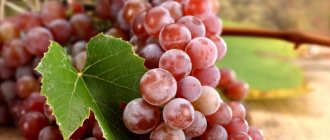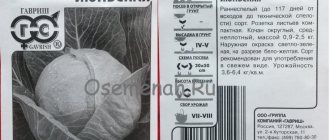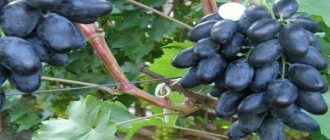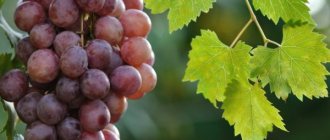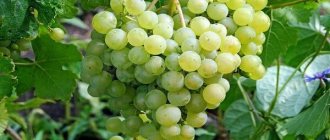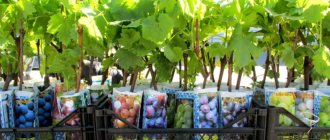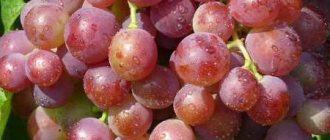Early Preobrazhenie grapes are considered one of the most productive, large-fruited and beautiful. For its worthy characteristics and unpretentiousness, the variety has received recognition from both professional winegrowers and amateur gardeners.
elite grape variety “Preobrazhenie” is distinguished by high yield and dessert taste of berries
grape variety "Preobrazhenie"
bunches of Preobrazhenie grapes tolerate transportation well and have an attractive presentation
History of selection
The Transfiguration grape was obtained as a result of a complex crossing of the Kishmish radiant and Talisman varieties by a practitioner and breeder by vocation, V. N. Krainov from Novocherkassk. In 2014, the variety was included in the State Register of the Russian Federation.
The grape form received the best characteristics from the basic varieties:
- early harvest ripening;
- excellent taste of fruits;
- high yield.
During the breeding work, three varieties similar to each other were bred: Preobrazhenie, Victor and Yubilei Novocherkassk. They are the ones who make up the famous “Kraynov Troika”.
Description of grapes
Botanical description of the Transfiguration grape:
- Vine. The bush is vigorous, with intensive shoot formation and a powerful root system. The leaves are glossy, medium-sized, without pubescence, five-lobed, on a long petiole. Shoots are 2.5-3 m long.
- Bunches. Heavy clusters of medium density and cylindrical-conical shape are formed. Their weight, with proper care and favorable weather, can reach 2-3 kg. The average weight of a bunch of grapes is from 800 g to 1 kg. Grapes are not prone to peas. The berries in the bunch are not deformed.
- Berries. Ripe berries are amber-pink in color, very large, reach 4.5 cm in length, about 2.5 cm in width, and are cylindrical in shape. The dense pulp is filled with clear juice. The seeds are medium, 2-3 per berry. The fruits are not prone to cracking; even when left on the bush for a long time, they are difficult to tear away from the bunch. The skin is of medium thickness and density, with a slight waxy coating.
When the vine is overloaded with berries, their taste deteriorates. The fruits turn out fresh and watery.
Characteristics
The main feature of the Transfiguration grapes is considered to be the large weight of the bunches and the size of the berries. The length of one berry can reach 5 cm, and weight – 17-20 grams. The taste of the harvest is also very pleasant: the sweet pulp with a slight sourness is not spoiled at all by the medium-thick skin. In this case, the seeds in the pulp are almost completely absent. All these features, combined with good shelf life and transportability, make this hybrid one of the best on the modern market (Figure 2).
Main characteristics of Transfiguration
The bushes grow quickly and do not require complex care. A variety with a short ripening period allows you to get decent yields where summer does not last long. An important factor contributing to the expansion of the geography of cultivation of the Preobrazhenie variety is its good resistance to frost.
Watch a video review of the Transfiguration grape variety below:
Below are the characteristics of the variety:
| Characteristics/parameters | Description/meaning |
| Ripening time | Early and very early. The timing depends on the growing region and weather conditions. Until full ripening – 105-115 days. The first fruits can be tasted on the 100th day. |
| Frost/drought resistance | Average. The plant can freeze at a temperature of -18ºС. Needs reliable shelter. Drought resistance is average. |
| Pollination | Self-pollinating, flowers bisexual. |
| Productivity and fruiting | A consistently high-yielding variety, on average one bush yields 20 kg, from 1 hectare - 236 kg. In the southern climate, 2 harvests can be harvested per season (in July and October). |
| Resistance to diseases and pests | Low resistance to diseases: powdery mildew, bacterial canker, spotty necrosis, etc. Wasps, grape flea beetles, and cushion flies can cause great harm to the vineyard. |
| Taste qualities | Pleasant, delicate, harmonious taste. There is a slight sourness, no aroma. Sugar – 17-19%, acidity – 7 g/l. The pulp is fleshy, juicy, sweet. The tasting score of fresh grapes is 8.5. |
| Berry weight | Average – 14 g, maximum – up to 20 g. |
| Direction of use | Table variety. |
| Application area | Used fresh to make raisins, homemade wine, and juice. The grapes are suitable for compotes, preserves, jams, and can be pickled. |
| Regionality | All regions of the Russian Federation where grapes are traditionally grown, as well as central Russia. |
| Transportability, storage | Tolerates transportation well. Does not lose its presentation for a long time when stored in a ventilated, cool room (temperature 8-10 degrees). Shelf life – up to 6 months. |
Comparison with other varieties
| Transfiguration | Cardinal | Baikonur | |
| Ripening period | 110-115 days | 115-120 days | 105-110 days |
| Frost resistance | up to -21 degrees | up to -22 degrees | up to -23 degrees |
| Productivity | 20-27 kg per bush | 20-25 kg per bush | 15-16 kg (up to 30-40 kg) per bush |
| Bunches | 600-1500 g (up to 2600 g) | 340-500 g | 700-800 g |
| Taste | harmonious, simple | pleasant, with faint muscat notes | harmonious, simple |
| Color | all shades of pink | from purple to black | dark purple |
| Disease resistance | low | average | above average |
| Shelf life | 2 months | 3 months | 2 months |
| Sugar accumulation | 19 % | 17-18 % | 19-20 % |
| Acidity | 6-7 g/l | 6-7 g/l | 6-7 g/l |
Advantages and disadvantages of the variety
The strengths of the variety are:
- high productivity;
- large fruit;
- self-pollinating, which makes it possible to grow Transformation in greenhouses; pollinating varieties are not required;
- early fruit ripening;
- undemanding to the type and composition of the soil;
- high commercial qualities: beautiful, large grape clusters attract attention;
- does not lose its presentation for a long time, good transportability;
- not prone to peas;
- the opportunity to harvest a second harvest per season from stepchildren in regions with a warm climate;
- good rooting of seedlings;
- the variety easily takes root on various rootstocks;
- adapted to different climatic zones.
Disadvantages of Grape Transformation:
- low resistance to fungal diseases;
- predisposition of shoots to fattening;
- the variety is attractive to insects;
- when the vine is overloaded, the taste of the fruit deteriorates.
Growing areas and features
The Preobrazhenie grape variety grows better in those regions of Russia where the crop is most often grown, that is, in the south. However, gardeners in Central and Central Russia also tried this variety in their garden plots, and they liked the result. Agricultural technology is a little more complicated due to climatic conditions, but the result is worth it. This variety is successfully grown in both Belarus and Ukraine.
Vineyard in the Krasnodar region - a classic of the genre
Features of planting grapes
The survival rate of the hybrid form of the transformation is good, the seedling quickly adapts in place, but for rooting, intensive growth and development, the plant must be properly prepared and planted.
When to plant?
The time for planting is chosen taking into account the climate of your region. You can plant grafted and own-rooted Transfiguration grape seedlings in spring and autumn. This is most often done in the spring, when the soil warms up to 7-8ºС.
Planting cuttings of a one-year-old fruit-bearing vine is carried out later, at a soil temperature of 10-12ºС, and air temperature not lower than +15ºС. It is better not to plant such planting material in the fall.
Selecting a location and preparing a planting hole
The taste of the grapes and the richness of their color largely depend on the level of illumination of the area. Sweet berries with an intense blush are obtained when the plant does not lack light. Therefore, it is important to choose a location away from large trees and shrubs.
The place should be calm, sunny, on the south side of the site, ideally protected from the wind by a building wall or fence. The groundwater level is at least 1.5 m from the soil surface.
For spring planting of seedlings, the hole is prepared in the fall:
- Dig a hole measuring 60x60 cm, the depth is the same.
- Place the top layer of soil close to the hole.
- Place the less fertile lower layer of soil on the other side.
- Place 1 bucket of compost or rotted manure at the bottom of the hole (you can mix organic matter 1:1).
- Apply potash and phosphate fertilizers (100 g each).
- Fill with half the soil taken from the top layer.
- Stir, add another bucket of organic matter and the same dose of fertilizer.
- Rake the second part of the fertile soil into the hole and mix.
- Fill the hole to the top with soil from the bottom layer.
With this method of distribution of nutrients, the roots will not be able to find nutrition in the upper layers and will begin to grow deeper. This arrangement of the root system will help the grapes withstand both drought and winter cold.
Preparation of seedlings
The best survival rate of grapes planted in spring. Purchase seedlings in advance or prepare cuttings yourself. The root system of a healthy seedling is whitish in color, and the cut of the stem is green. Check the integrity of the bark; there should be no damage.
If the plant has produced new sprouts from the buds, they are removed, leaving one of the largest ones. Remove dried branches and leaves, if any. The top of the main sprout is cut off, leaving a part of the stem with five eyes.
The tips of the roots are trimmed so that their total length does not exceed 15-17 cm. Next, the roots of the plant are soaked in water at room temperature, to which one of the stimulants is added, for example, Kornevin or Humate. All this is done 1-2 days before planting.
Step-by-step instructions for landing
In mid-spring, when the earth has warmed up, they begin planting grapes. It consists of the following steps:
- make a hole with a mound in the middle in the hole prepared in the fall;
- lower the seedling onto the mound and spread the roots of the plant evenly;
- cover with soil, compacting it well;
- pour plenty of water;
- mulch the tree trunk circle.
Features of vineyard watering
Grape bushes need to be watered at least once a month, starting in May. If the summer is dry, watering should be done more frequently (once every 2-3 weeks).
Irrigation is carried out according to a schedule, not paying attention to rain, since in order for the plant to receive a sufficient amount of moisture, approximately 60-80 liters of water are needed.
To prevent crusts from forming on the ground after watering, the soil is covered with mulch with approximately a layer of 5-8 cm, which protects the soil from drying out and also additionally enriches the soil with microelements.
Watering is combined with fertilizing of the vineyard. Usually, for these purposes, a barrel of warm water is prepared in advance, in which organic or mineral fertilizers are dissolved. On both sides of the bushes, ditches are dug between the rows. They are made at a distance of a meter from the trunk of the grape bush, because this is where the feeding roots of the plant lie. The depth of the groove is approximately one bayonet of a shovel.
Young bushes (up to 3 years old) are watered in tree trunk holes or in a special pipe, which is sometimes left for watering seedlings.
Care after planting and further cultivation
Subsequent care of grapes consists of pruning, watering, fertilizing and protection from diseases and pests.
Watering
The hybrid form Transformation requires regular watering, but does not tolerate excessive amounts of water. The root system of the plant goes deep into the soil, and so that moisture reaches all the roots, it is watered with large portions of water.
Excessively abundant watering has a negative impact on the taste of berries. The fruits become tasteless, with watery pulp.
Water the plants according to this scheme:
- The first time after planting, pour out two buckets of water once a week.
- A month later - once every 3-4 weeks (4 buckets).
- Moisture-charging irrigation is carried out in spring and autumn, despite the presence of precipitation: autumn - so that the vine can more easily endure the frosty period;
- spring - to activate the kidneys.
For surface watering, if an underground soil moisture system is not provided, a groove 20 cm deep is made around the bush, at a distance of 30 cm from the root collar. Water is poured into this groove.
When, how and with what to fertilize?
The plant must receive the entire complex of necessary nutrients. The table will help you figure out when, what and why you should feed growing grapes:
| Top dressing | How? | When? | For what? |
| 1st root feeding | 40-50 g of nitrophoska per 1 sq. m | 7-14 days before flowering. | The pollination process goes better, the clusters are larger. |
| 1st foliar feeding | Usually carried out in conjunction with spraying the bushes with fungicides. Mix 2-3 g of copper sulfate, 10-20 g of boric acid and 23 g of iron sulfate in 10 liters of water. | 2-3 days before flowering. | Reduces shedding of ovaries. |
| 2nd root feeding | 30-60 g of nitrophoska per sq. m | 14-16 days after flowering. | Provides active growth of berries and shoots. |
| 2nd foliar feeding | 1 g of potassium permanganate, 30-40 g of urea, 20 g of citric acid, 10-15 g of iron sulfate. | The fruits are in the small pea stage. | Prevents ridge paralysis and grape chlorosis. |
| 3rd root feeding | 1 tbsp. l. potassium magnesia, 15 g of potassium salt, 20 g of superphosphate. | 7-14 days before fruit ripening. | Improves the taste of berries, prevents their cracking and slightly accelerates ripening. |
| 4th root feeding | For 10 liters of water, 1-2 tablets of microfertilizers or ash infusion. | Before the berries ripen. | Prevents gray mold disease, improves the taste characteristics of fruits. |
| 5th root feeding | 30-40 g of superphosphate, 20-30 g of potassium sulfate. | After the harvest. | Improves the ripening of shoots. |
Features of mulching
In order to preserve moisture and nutrients in the soil, as well as to protect the plant from slugs, mulching is carried out in the fall and spring. To do this, use peat, humus, bark, sawdust or straw. The tree trunk circle is mulched with a 3 cm layer of organic matter. During the period of frost, mulch plays the role of insulating the grape bush.
Trimming and shaping
Without shaping and pruning there will be no good grape harvest. A dense vine promotes the development of diseases. Pruning can be done before the buds swell in spring or autumn. The average number of shoots on a bush is 24-30 pieces.
We recommend reading the article about spring pruning of grapes.
Using trimming:
- the number of grape bunches is regulated;
- the shape of the bush is formed;
- shoot growth is activated.
For the Transfiguration, a fan type of formation is recommended. The length of the fruit vine is shortened to 6-8 eyes. During the growing season, pinching is carried out in order to collect a full-fledged main harvest. If you expect to receive a second harvest in October, then this is not necessary.
Due to the large size of the fruits and clusters, the Preobrazhenie variety needs to be rationed. Only one bunch of grapes is kept per shoot. Alternatively, you can solve the problem by pinching off the bottom of the bunch by 1/3 or 1/4. This is done at the initial stage of cluster formation, when the fruits are the size of a pea.
Large grape varieties must be rationed, otherwise the harvest will remain unripe, and an overly overloaded bush will not have time to prepare for wintering.
Bird protection
There are two main ways to protect crops from birds: isolation and repelling:
- Isolation: ripening bunches are placed in protective bags (plastic mesh, vegetable nets, etc.);
- a small vineyard is completely covered using tulle, fishing net and other materials in a fine mesh.
- Plastic bags cut into strips are hung on the trellises (blue is preferred - birds are afraid of blue and mirrored).
It is useless to use a scarecrow or CDs without noise accompaniment. Birds quickly get used to it and are not afraid of such means of protection.
Preparing for winter
In autumn, shoots are cut to 1/4 of their length. When the thermometer drops below -5ºС, it is time to cover the grapes. Having been removed from the supports, the vine is laid on the ground, pinned with garden staples, and covered with roofing felt, burlap, covering material, etc. A layer of soil up to 10 cm thick is poured on top.
Care and planting
A growing bush must be pruned annually for more productive fruiting. Considering the characteristics of this hybrid form, which has high yields and heavy clusters, it is recommended to normalize the inflorescences on the shoots. One shoot - one inflorescence.
REFERENCE: Some winegrowers remove the shoots, believing that their growth retards the development of the main crop, on which they place the main emphasis.
Covering for the winter is necessary to avoid freezing of the shoots. To do this, cut the vine by ¾ and cover it with mulch or sawdust.
Grapes are pruned in the fall. If this has not been done, then in the spring circumcision is carried out before the buds open.
The variety is unpretentious to soil, but planting in chernozem soil significantly improves the weight and taste of the fruit.
Considering the growth rate of the bushes, it is not recommended to plant grapes in close proximity to trees or other shrubs.
When planting, you need to take care of protection from the north wind, preferring a place near a fence or along the wall of a house. Also, lighting plays an important role for good ripening of fruits.
Cuttings and grafting
Grafting cuttings is another way to plant Transfiguration grapes. It is necessary to ensure that the selected cuttings are healthy and suitable for planting:
- Each cutting should have at least 2-3 eyes. From the cut of the cutting to the lower eye there should be no more than 3-5 mm. If the distance is greater, the excess is cut off.
- Before planting, the cuttings are placed in a container with warm water, to which a few drops of a growth stimulator are added. Soak for a day.
- If grafting is done in the fall, then to increase frost resistance and preserve moisture, the tip of the cutting is dipped in hot paraffin. Then immediately dip into a container of cold water.
- The rootstock must be split so that one cutting can fit there. It is cleaned until smooth.
- The junction of the rootstock and the cutting is tightly tied along the rootstock with cloth. The grafting site is coated with clay.
To prevent the grapes from freezing, you need to wrap them before the onset of frost.
How to prune vines correctly
Pruning of the Transfiguration grapes is carried out at a convenient time on a dormant vine (February-March), when severe frosts are no longer expected (below -20 degrees). Since the variety is medium-sized, the pruning is done medium-sized, with 4 and 8 buds. However, it has been noticed that even with long pruning, the grapes produce excellent yields. About 40 eyes are left on the bush, depending on the condition and age of the vine.
“Transfiguration” bushes can reproduce in all ways: seeds, cuttings, layering and seedlings. The seeds have good germination, but due to the fact that there are few of them in the berry (2-3 seeds), this type of propagation is used least often. Transfiguration scions grow and bear fruit very well on a strong vine of a different variety. Grafted bushes give an excellent harvest the next year.
To make the clusters larger, they can be normalized, leaving only one or two strong clusters on each vine, while the rest are cut off during pruning of the stepsons.
Diseases, treatment and prevention
Transformation is not highly resistant to disease. The most common diseases and ways to combat them are presented in the table.
| Disease | Symptoms | How to fight? |
| Powdery mildew (oidium) | Fungal disease. White coating on grape leaves and berries. The skin of the fruit cracks and the leaves wither. Then the shoots dry out, the berries and leaves fall off. | Fungicides are used: Topaz, Vitaros, Fundazol, Fitosporin-M, bio-fungicide Alirin-B and many others. etc. Folk remedy: dissolve 4 g of soda ash and the same amount of soap in a liter of water. Spray 2 times at weekly intervals. |
| Spotted necrosis | Appears after wintering under cover. Dark oblong spots of dead tissue appear on the wood, under the bark, then the affected part of the plant dries out and dies. | Treatment and prevention:
|
| Mildew (downy mildew) | Lightening of the leaves, the appearance of small round spots of reddish-yellow color. Then the underside of the leaf becomes covered with a white coating. In addition to leaves, inflorescences, shoots, and berries are also affected. The bush may die. | Treatment is carried out in several stages:
Copper sulfate is an effective remedy in the early stages and for prevention. Preparations: Abiga-Pik, Strobi, bio-products Planriz or Alirin-B. In case of severe damage, organic fungicides with copper or sulfur are used: Ridomil Gold, Champion, Cabrio Top. |
| Bacterial cancer | It gets on the plant when it is processed with a non-sterile instrument. The bark cracks and tumor-like growths form. | There is no treatment; the infected bush is destroyed. |
Preventive measures, including treating plants with Bordeaux mixture, will help to avoid the appearance of many dangerous bacterial and fungal diseases of grapes.
The first treatment is carried out in the fall, when the leaves have fallen, by spraying the grape bushes and the ground under them. The second is for unopened buds. The third spraying is carried out on shoots 10-12 cm long.
Bordeaux mixture is used only for prevention. If signs of disease appear on the leaves, then they move on to more effective methods and treat the grapes with the necessary preparation.
Diseases and pests
Preobrazhenie grapes are not resistant to diseases such as bacterial canker, mildew, spotted necrosis and powdery mildew.
Among the pests to which the plant is exposed:
- grape moth;
- pad;
- grape spider mite.
Powdery mildew
Powdery mildew is a fungal disease that appears on leaves as a white coating. To get rid of it, you will need to use fungicides: Vitaros or Topaz.
Spotted necrosis
This disease can appear on grapes after winter. First, spots appear on the leaves, after which the vine dries out and dies. The most suitable means for combating spotty necrosis are preparations that contain copper.
Mildew
Mildew is one of the most dangerous fungal diseases of the Transfiguration grape. Infestation can be identified by lightening of the leaves, on which yellow oily spots appear. This disease can be cured with antifungal drugs containing copper.
Bacterial cancer
If you handle grapes using unsterile tools, you can infect the plant with bacterial cancer. This disease cannot be cured. The only thing that can help is removing the infected vine.
Prevention methods
Preventative measures are necessary to prevent the occurrence of diseases and pests, which are easier to prevent than to try to cure.
Sweet baits
The plant is often attacked by hornets, wasps and larvae. For this purpose, chemical preparations without a strong odor have been developed that do not interrupt the smell of the bait. It is worth choosing products that are considered safe for both humans and fetuses. Sweet baits are made from plastic bottles filled with a liquid with a strong aroma that will attract wasps. They are hung near the vineyard.
Mesh bags
A bunch of Transfiguration grapes, without cutting them from the branch, are placed in a bag with 1 mm cells made of synthetic material. You can use tights, bandage, gauze.
Tie the bag with several knots to prevent wasps from getting inside. You can secure it with a clothespin. The bag should not come into contact with the bottom of the bunch.
Smoke
Smoke bombs have become widespread in the fight against insects. Because of the smoke, pests fall to the ground, where they can then be crushed. After the colony is destroyed, the empty nest must be removed.
Artificial repeller
To combat wasps, an artificial repeller is made using table, apple or grape vinegar.
To prepare the solution you need:
- cold water - 1 l;
- vinegar - 100 ml.
Spray the grapes with the prepared solution early in the morning.
Another method can be used. Have to take:
- cold water - 10 l;
- liquid laundry soap - 20 ml;
- baking soda - 5 tbsp. l.
Processing is carried out in the morning or in the evening.
Destruction of wasp nests
The most effective method of controlling insects is to destroy wasp nests. They are carefully sprayed with Dichlorvos. After this, they are removed and burned.
Grape spider mite
Grape spider mites infect grapes at any age. The warm and dry climate contributes to its mass reproduction. Getting rid of the pest is facilitated by crops that have phytoncidal properties, which many insects are afraid of - garlic and onions. You can also use insecticides.
pad
The cushion borer is a pest that loves grape juice. It is placed on the shoots and creates a film, which makes it almost invisible and resistant to insecticides. You can only get rid of the cushion by collecting the pests manually.
grape moth
The grape moth is located on the lower part of the leaves, laying larvae. When the offspring hatch, they begin to feed on the juice of the berries. To get rid of these pests, Transfiguration grapes are treated with insecticides, fallen leaves are removed, and the soil is loosened.
Pests, control methods and prevention
Maximum damage to grape bushes The transformation is caused by wasps, which are attracted by the high sugar content of the fruit. In large quantities, they flock to the vineyard, eat up the juicy, sweet pulp, as a result of which the damaged berries spoil and the bunches of grapes lose their marketable appearance.
Fighting them is difficult and often futile. You can use the following methods of protection against wasps:
- Sweet baits . They are made from plastic containers into which honey water, fermented compote or syrup are poured. Baits are hung in sunny places.
- Mesh bags . A bag made of gauze, tulle and similar materials is put on each bunch of grapes and tied at the top.
- Smoke . You can drive away wasps with “Liquid Smoke” or smoke from a fire.
- Artificial repeller . They use the drug Sochva Zh, it is non-toxic. When it settles on the fruits and leaves, the smell of smoke remains, repelling insects.
- Destruction of wasp nests . Insecticides are used against wasps. In the dark, the nest with insects is treated with the drug on all sides, especially in the middle. It is important to reliably protect all parts of the body with protective clothing. Use a flashlight with red glass as a light source.
In addition to wasps, other insects also cause significant damage to grape plantings. The table below shows the most common of them.
| Pests | Damage caused | Control measures |
| Grape spider mite | It lives on the underside of the leaf, actively devouring its tissue. A whitish-yellow coating and light spots appear on damaged leaves, and over time they dry out. |
|
| pad | It feeds on sap, attaching itself to shoots and leaves. Produces a protective film through which insecticides do not penetrate. The plant loses vigor and dies. | The most effective method is to collect insects by hand. |
| grape moth | Lays eggs on the underside of leaves. The emerging caterpillars, feeding on the sap, gnaw holes in the leaves. Light stripes form on the leaf plate. | Disposal of fallen leaves, loosening the soil around the grape bush and applying an insecticide. |
How to prepare a vineyard Transformation for winter
Transformation requires obligatory shelter during winter
. The shoots are collected in separate bunches and bent to the ground, secured, for example, with a metal bracket. You can use slate.
Preparing grapes for winter - video
On top they make a thick covering layer of pine spruce branches, fallen leaves, river sand, sawdust, and hay. There is a special material designed specifically for covering plants for the winter. It allows air to pass through well and is an excellent shelter option.
Reviews of grapes Transfiguration
★★★★★
Igor Nikolaevich, 41 years old, aspiring winegrower, Crimea. In terms of its ability to form inflorescences in August and then produce a second harvest in October, Preobrazheniya is the undisputed leader.
The rich pink fruits of the October harvest stood out well against the background of the autumn varieties. No other advertising was required to sell seedlings. ★★★★★
Valentina, 33 years old, summer resident, Maykop. This year the berries of the Transfiguration are more beautiful and brighter than last year.
I came to the conclusion that the color depends on the sun. If the vine is well lit, then the berries are more beautiful and sweeter. And if there is a small shadow, they turn out pale. Hide
Add your review
Grapes Transformation, when all necessary agrotechnical measures are carried out, will certainly please you with a bountiful and beautiful harvest. Despite the young age of the variety, it is a worthy choice for both growing in a summer cottage and for commercial gardening.
0
0
Copy link
Which regions are best to grow in?
Preobrazhenie grapes prefer warmth, light, lack of wind, and fertile soil. A distinctive feature is resistance to low temperatures.
For these reasons, the variety can be cultivated in several regions of the country:
- North Caucasian.
- Nizhnevolzhsky.
- Ural.
- Central.
The variety can be grown in a variety of areas. It is enough to create the correct, necessary conditions for planting. Correct implementation of care procedures will keep the bush healthy and fruitful for many years.
The Preobrazhenie variety has long become a popular planting in summer cottages. An unpretentious shrub does not require careful care. Among its many advantages: abundant harvest, early fruiting, large and sweet berries. An excellent place for cultivating the plant will be a warm, sunny region. Thanks to their frost resistance, grapes can be planted in areas with fluctuating low temperatures. The excellent taste of the fruit has made the shrub in demand by many gardeners and commercial production.
